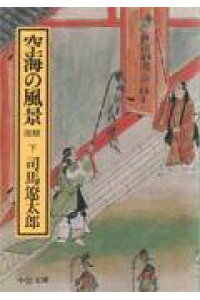司馬遼太郎 著「空海の風景 下巻」 中公文庫
上巻に続き、司馬遼太郎の「空海の風景」の下巻を読みました。いくつか知識の整理になる個所があったので、メモを残しました。講義をする際に気になっていた部分が、少し明快になった部分もありました。
1つめは、曼荼羅です。歴史の教科書で習って以来、いつも胎蔵界と金剛界の違いがよくわからず、曼荼羅の前で呆然とすることが多いのですが、本書では次のように記述されていました。「曼荼羅は聖像や偶像ではなく、真理(大日如来)が宇宙で運動してゆく運動の発現形態を示すもの(胎蔵界)であったり、その運動が真理へ帰一してゆく形態を示すもの(金剛界)であったりする。」わかったような、わからないような感じですが、曼荼羅を見ながら、再確認したいとおもいます。
2つ目は、遣唐使が唐から持ち帰った書物についてです。一説によると約17,000巻の書物を書写して持ち帰ったと言われていますが、実際はどうなのか確信が持てないでいました。本書によると、「空海が日本に帰って上表した書目が、461巻になっている。」そうです。これは記録として残っているので確からしいです。また、空海の母方の氏族から出た玄昉という在唐18年で、後に聖武天皇にお仕えした人ですが、「経論5千余巻というおびただしい仏書を請来した」そうです。お経が沢山持ち込まれているので、約17,000巻が持ち込まれたということもありえたでしょう。
3つ目は三筆についてです。歴史の授業か書道の授業で三筆として、嵯峨天皇、空海、橘逸勢を暗記した方も多いと思います。では、なぜ彼らが「三筆」と呼ばれるようになったのか、司馬さんは本書の中で推論を述べられています。平安京の門の額を三人で揮ごうしたことに遡るようですが、引用すると、「『寛平御記』によれば、嵯峨は東の三門と西の三門をうけもった。空海は南の三門と応天門をうけもち、橘逸勢は北の三門をうけもった。この三人がのちに三筆とよばれるようになったのは、この諸門の額の揮毫を三人でやったからであろう。」
空海は伝説の多い人なので、いろいろと人知を超えた話も多く伝わっていますが、本書ではオカルト的な話は取り扱っていないのが、良い所だと思います。それにしても空海の人生は波乱に富んでいて、最高のタイミングで、最高の人との出会いがあったように、非常に強運を引き付ける人と感じました。(完)

価格:817円
(2021/6/2 09:45時点)
感想(11件)
Kukai’s Landscape (English)
Ryotaro Shiba, “Kukai’s Landscape, Vol. 2”, Chuko Bunko
Following the first volume, I read the second volume of Ryotaro Shiba’s “Kukai’s Landscape.” There were some parts that helped me organize my knowledge, so I left notes. Some of the parts that bothered me when I gave lectures became a little clearer.
The first is the mandala. Ever since I learned it in my history textbook, I have always been unable to understand the difference between the “Taizokai” and the “Kongokai”, and have often been stunned in front of a mandala. “The mandala is not a holy image or an idol, but a manifestation of the movement of the truth (Dainichi Buddha) in the universe (Taizokai), or a manifestation of the movement that returns to the truth (Kongokai). I’m not sure if I understand it or not, but I would like to reconfirm it while looking at the mandala.
The second is about the books that the envoys brought back from the Tang Dynasty. According to one theory, they copied and brought back about 17,000 volumes of books, but I was not sure what the actual number was. According to this book, “Kukai returned to Japan and transcribed 461 volumes of his writings.” That’s right. This seems to be true since it is still in the records. A man from Kukai’s mother’s clan, Genoa, who lived in Tang Dynasty for 18 years, served Emperor Shomu. He brought a lot of sutras, more than 5,000 sutras, so it was possible that Japanese envoys totally brought about 17,000 volumes.
Third, let’s talk about “San Pitsu, the three most famous calligraphers”. Many of you may have memorized Emperor Saga, Kukai, and Tachibana-no-Hayanari as “San Pitsu” in history class or calligraphy class. In the book, Mr. Shiba explains his theory as to why they came to be called the “San Pitsu”. To quote from the book, “It seems that this dates back to the three of them scribbling the frames for the gates of Heian-kyo, capital city. According to the Kanpei Goki, Saga took charge of the three eastern gates and the three western gates, Kukai took charge of the three southern gates and the Otenmon gate, and Tachibana-no-Hayanari took charge of the three northern gates. These three men were later called the “San Pitsu” because they were responsible for the writing of the plaques for those gates.
Since Kukai was a man of many legends, there were many stories about him that were beyond human knowledge, but I thought it was a good thing that this book did not deal with occult stories. Kukai’s life was full of vicissitudes, and I felt that he was a person who attracted very strong luck, as if he met the best people at the best time. (End)
Le paysage de Kukai (Français)
Ryotaro Shiba, “Paysage de Kukai, Vol. 2”, Chuko Bunko
Après le premier volume, j’ai lu le deuxième volume du “Paysage de Kukai” de Ryotaro Shiba. Certaines parties m’ont aidé à organiser mes connaissances, j’ai donc pris des notes. Certaines parties qui me gênaient lorsque je donnais des cours sont devenues un peu plus claires.
Le premier est le mandala. Depuis que je l’ai appris dans mon manuel d’histoire, j’ai toujours été incapable de comprendre la différence entre le “Taizokai” et le “Kongokai”, et je suis souvent resté bouche bée devant un mandala. “Le mandala n’est pas une image sainte ou une idole, mais une manifestation du mouvement de la vérité (Bouddha Dainichi) dans l’univers (Taizokai), ou une manifestation du mouvement qui revient à la vérité (Kongokai). Je ne suis pas sûr de comprendre ou non, mais j’aimerais le reconfirmer en regardant le mandala.
La seconde concerne les livres que les envoyés ont rapportés de la dynastie Tang. Selon une théorie, ils ont copié et rapporté environ 17 000 volumes de livres, mais je n’étais pas sûr du nombre réel. Selon ce livre, “Kukai est retourné au Japon et a transcrit 461 volumes de ses écrits.” C’est exact. Cela semble être vrai puisque c’est toujours dans les archives. Un homme du clan de la mère de Kukai, Genoa, qui a vécu dans la dynastie Tang pendant 18 ans, a servi l’empereur Shomu. Il a apporté beaucoup de sutras, plus de 5 000 sutras, il est donc possible que les envoyés japonais aient apporté au total environ 17 000 volumes.
Troisièmement, parlons de “San Pitsu, les trois plus célèbres calligraphes”. Beaucoup d’entre vous ont peut-être mémorisé l’empereur Saga, Kukai et Tachibana-no-Hayanari comme “San Pitsu” en cours d’histoire ou de calligraphie. Dans le livre, M. Shiba explique sa théorie sur la raison pour laquelle on les a appelés les “San Pitsu”. Pour citer le livre, “Il semble que cela remonte au moment où ils ont tous les trois griffonné les cadres des portes de Heian-kyo, la capitale. Selon le Kanpei Goki, Saga s’est chargé des trois portes orientales et des trois portes occidentales, Kukai s’est chargé des trois portes méridionales et de la porte Otenmon, et Tachibana-no-Hayanari s’est chargé des trois portes septentrionales. Ces trois hommes ont été appelés plus tard les “San Pitsu” car ils étaient responsables de l’écriture des plaques de ces portes.
Comme Kukai était un homme aux nombreuses légendes, il y a beaucoup d’histoires à son sujet qui dépassent la connaissance humaine, mais j’ai trouvé que c’était une bonne chose que ce livre ne traite pas d’histoires occultes. La vie de Kukai était pleine de vicissitudes, et j’ai eu l’impression que c’était une personne qui attirait une très forte chance, comme s’il rencontrait les meilleures personnes au meilleur moment. (Fin)
